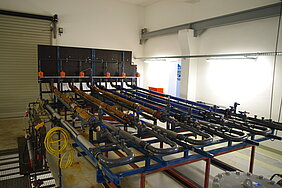Corrosion inhibitors are primarily used in water distribution with the aim of avoiding rusty water. As part of the project, a practical procedure is developed that makes it possible to assess the effect of inhibitor addition on the iron uptake of the water and deposit formation as a result of corrosion.
Corrosion inhibitors are primarily used in water distribution to prevent rusty water. A vital aspect of their use is the screening and monitoring of the inhibitor efficiency. Recommendations for this are provided in the DVGW worksheets W 215-1 and W 215-2. However, these can be difficult to implement or may not provide information that can be clearly interpreted. For this reason, an approach should be developed with which to evaluate the effectiveness of the inhibitor directly under the specific boundary conditions in the drinking water distribution system.
The research project was tackled in two sub-projects: sub-project I addressed the inhibitors’ mechanisms of action and sub-project II looked into the effects of changing the inhibitor concentration.
As a result of the investigations at the pilot plants, there was no evidence of the corrosion processes in grey cast iron lines being directly influenced by an inhibitor under the given boundary conditions. It is therefore not possible to clearly describe a possible mechanism of action of the inhibitor systems used in drinking water and concentrations on the corrosion process. Monitoring water quality directly in the network is therefore given particular relevance.
Investigations into the drinking water network showed that continuous turbidity measurements directly in the distribution system were a simple and quick method to clearly evaluate the iron uptake of the water from corrosion processes under the given system conditions. The speed that deposits form as a result of corrosion can be clearly determined by systematically flushing the system and recording the deposit situation.
Recommendations for industry were developed on performing turbidity measurements and flushing as well as for alternative measures on the control of abnormalities caused by rusty water.
Publications:
Lohmann, M.; Korth, A.: Bewertung der Wirkung von Korrosionsinhibitoren im Verteilungsnetz [Assessment of the effect of corrosion inhibitors in the distribution network]. Veröffentlichungen aus dem Technologiezentrum Wasser [Publications from TZW] 82, ISSN 1434-5765 (2018)

![[Translate to English:] Prüfstelle-Produktprüfung_Teststand Test centre and product testing](/fileadmin/_processed_/0/9/csm_TZW-Karlsruhe_Pruefung_Geraete-Teststand_377188946c.jpg)

























